Gunner's Mate
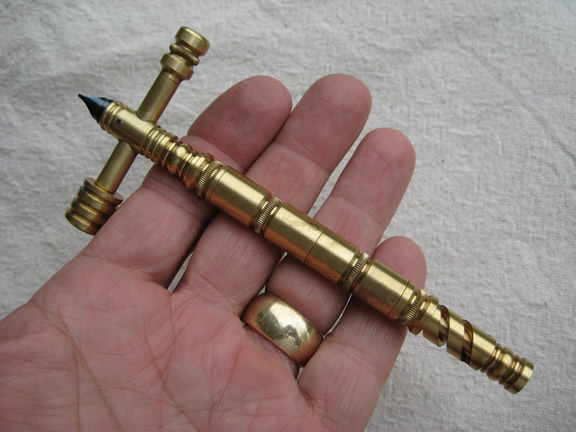
There are just those days shooting in the field when things go wrong, and if you don’t have the right items in your pouch or pocket, the day is going to be a waste. Load a ball without powder, end up with a dull flint or a fouled vent, lose a cleaning patch down the bore, or break a ramrod trying to use a ball puller. Just think of this single, light weight, ten-function multi-tool as a Swiss Army knife for muzzleloading shooters.
Specifications: The Gunner’s Mate is all brass and is designed in an 18th century style, including an antique pattern knurl rings around the body that make it easier to manipulate. The tool features 10-32 threads at all interfaces, allowing the components to be reassembled in the many different required configurations. To use this tool, your ramrod must have 10-32 female threads on both ends.
With the appropriate bore adapter/jag, the tool can be used in bores from .45 to .75 caliber. The bore specific parts are interchangeable, so a single tool can be used with several different caliber guns. There is also a special brass rod for use with pistols.
Price:
Gunner’s Mate $88
(comes with one standard bore adapter/jag set – please specify caliber)
|
Extra bore adapter/jag set $18
(please specify .45, .50, .54., 56, .58, .62, or .75)
|
Pistol three-piece brass rod $45
|
More Details :
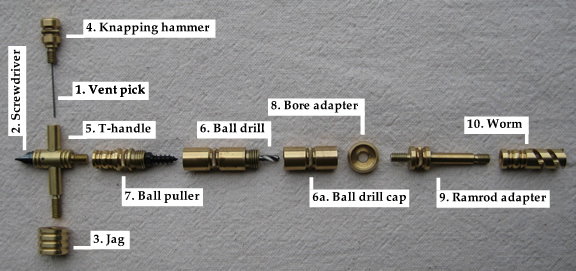
The Gunner’s Mate combines the most useful functions for in-the-field muzzleloading repair and servicing, eliminating the need to carry around individual small tools that are sharp or easy to lose, and preparing the shooter for all eventualities. I originally designed it for my own use, and it is, as far as I know, the only tool of its kind. (A design patent is pending.)
The tool combines ten features, shown in the picture above, and can be reassembled in several ways to facilitate different functions. Those functions include clearing a vent; sharpening a flint; drilling or pulling a projectile to be removed; capturing and clearing a bore obstruction; cleaning a bore; providing a more positive grip on the ramrod for various operations; and removing, servicing or replacing any part of the firearm retained by a screw, including a flint or lock.
|
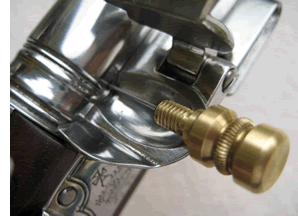 1. Vent pick: The vent pick, used to clear a flintlock vent or percussion nipple, is a spring steel wire held in a small brass handle. The wire is sized to accommodate the flash channel of a flintlock or matchlock, or the nipple of a pill lock, tube lock or percussion cap firearm. The spring steel wire is hard but very smooth, so it won’t enlarge the touchhole with use. 1. Vent pick: The vent pick, used to clear a flintlock vent or percussion nipple, is a spring steel wire held in a small brass handle. The wire is sized to accommodate the flash channel of a flintlock or matchlock, or the nipple of a pill lock, tube lock or percussion cap firearm. The spring steel wire is hard but very smooth, so it won’t enlarge the touchhole with use. |
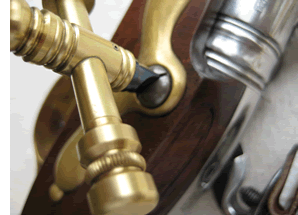 2. Screwdriver: The screwdriver is most often used to remove and replace a flint. It can also be used to remove the lock — or any other part secured with a screw — for servicing and cleaning. 2. Screwdriver: The screwdriver is most often used to remove and replace a flint. It can also be used to remove the lock — or any other part secured with a screw — for servicing and cleaning.
Removing a lock screw. |
3. Jag: The jag is used in conjunction with the ramrod adapter (see function 9, below). The tool is ordered set up for any caliber between .45 and.75 but can be converted to other calibers by replacing the jag and bore adapter, which can be ordered separately.
Ramrod adapter and jag installed on ramrod.

|
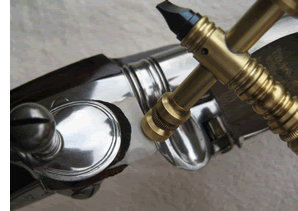 4. Knapping hammer: When in its stored position, the handle of the vent pick (see function 1, above) forms the face of a knapping hammer for refreshing a flint edge. 4. Knapping hammer: When in its stored position, the handle of the vent pick (see function 1, above) forms the face of a knapping hammer for refreshing a flint edge.
Knapping a flint. |
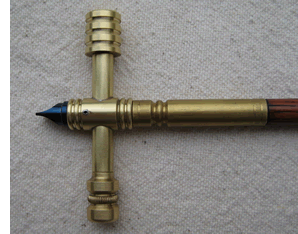 T-handle installed on ramrod. T-handle installed on ramrod.
5. T-handle: The T-handle attaches to your firearm’s ramrod, with a threaded connection, allowing the user a much firmer grip and better control of the ramrod. Because it is detachable, it does not interfere with the ramrod's normal look or storage position beneath the barrel of the firearm. With cold hands or a rod slippery with patch lube, the T-handle greatly facilitates the drilling and pulling of a projectile (see functions 6 and 7, below), and the use of the jag (see function 3, above) and the worm (see function 10, below). |
6 & 7. Ball drill / Ball puller: The ball drill and ball puller are used in succession to remove a projectile that cannot be fired out of the bore because of a wet charge, a ball loaded without powder, or other malfunctions. While the ball puller can be used alone, using the ball drill first greatly reduces the torque required to screw the ball puller into the projectile, reducing the risk of damaging the ramrod and/or jamming the ball even tighter in the bore. The bore adapter (see function 8, below), placed between the ramrod adapter and the ramrod, keeps the ball drill and puller centered in the bore.
Bore adapter, ramrod adapter, and ball drill installed on ramrod end. The ball puller is located under the ball drill.

Bore adapter, ramrod adapter and ball puller installed on ramrod.

|
8. Bore adapter: As noted above, the bore adapter keeps the various tools centered in the bore of larger-caliber firearms to prevent bore damage. It’s shown installed on a ramrod with the ball drill and ball puller (functions 6 & 7) above.
|
9. Ramrod adapter: The ramrod adapter is used with almost all of the other tool components. It is equipped with male threads on both ends and includes one long leg and one short leg. It can be turned end for end, as may be required, to use the various other bore tools.
|
10. Worm: The worm is threaded onto the end of the ramrod adapter and is used in the normal manner to clean or clear the bore.
Ramrod adapter and worm installed on ramrod.

|
Special Note: Pistol Ramrods
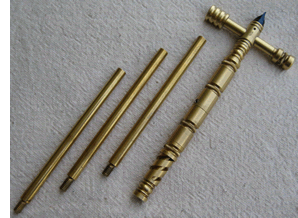 Gunner’s Mate with three-piece brass pistol rod. Gunner’s Mate with three-piece brass pistol rod.
I have several flintlock pistols that have traditional pistol ramrods, without threads on both ends. In order to use the Gunner’s Mate with these pistols, I made a three-piece brass rod to use in place of a ramrod. Each section is 4 inches long, so the three pieces, plus the Gunner’s Mate, should handle any common pistol barrel length. |
[Click on any picture to enlarge]
|













